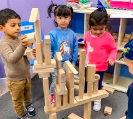Choosing the right preschool is a big decision for parents. Among the many options available, Montessori and traditional preschool programs are two of the most popular. While both approaches aim to support early childhood development, they differ in teaching methods, classroom structure, and educational goals. Understanding these differences can help families make the best choice for their child’s learning style and needs.
Montessori Education: A Child-Centered Approach
Montessori education is based on the philosophy of Dr. Maria Montessori, who believed that children learn best through hands-on experiences and self-directed activity. In a Montessori classroom, children are free to choose their activities from a carefully prepared environment designed to promote independence and curiosity.
Key features of Montessori preschool include:
Mixed-age classrooms, encouraging peer learning and collaboration.
Individualized learning plans, allowing children to work at their own pace.
Specialized materials, designed to build practical life skills, sensory development, and academic understanding.
Minimal direct instruction, with teachers acting as guides rather than traditional instructors.
This approach encourages responsibility, concentration, and a deep love for learning that can benefit children well beyond the preschool years.
Traditional Preschool: Structured Learning and Group Activities
Traditional preschool programs typically follow a teacher-led model. The day is divided into structured activities, including circle time, story sessions, crafts, and academic instruction. Lessons are usually delivered to the entire group, with children expected to participate at the same pace.
Highlights of traditional preschool include:
Uniform curriculum, with a clear focus on early literacy, math, and social skills.
Age-specific classrooms, where children are grouped based on age.
Teacher-directed learning, emphasizing routine and group cooperation.
Set daily schedules, helping children adapt to consistent learning patterns.
This structure can provide a strong foundation in classroom behavior and basic academic skills, preparing children for the transition to kindergarten and elementary school.
Which One Is Right for Your Child?
Both Montessori and traditional preschools offer valuable early learning experiences. The best choice often depends on your child’s personality, your family’s educational goals, and the teaching environment you value most.
A Montessori program might suit children who enjoy independence, hands-on learning, and working at their own pace. On the other hand, a traditional preschool may be ideal for children who thrive in group settings, benefit from structured routines, and enjoy interactive group activities.
Final Thoughts
There’s no one-size-fits-all answer when it comes to early childhood education. Whether you choose Montessori or a traditional preschool, what matters most is finding a program where your child feels happy, engaged, and supported in their early learning journey.














